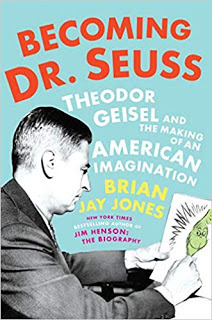Learning from Dr. Seuss
 Hello and Happy Poetry Friday (the 13th)! Be sure to visit Laura (who has a brand new book in the world!) at Writing the World for Kids for Roundup.
Hello and Happy Poetry Friday (the 13th)! Be sure to visit Laura (who has a brand new book in the world!) at Writing the World for Kids for Roundup.I am away from my desk, but I wanted to pop in with some words of wisdom from Dr. Seuss, as I've just finished reading BECOMING DR. SEUSS: Theodor Geisel and the Making of an American Imagination by Brian Jay Jones. I learned a lot about Ted the man and Dr. Seuss the writer... and I found some valuable advice for writers and poets currently trying to get published in the children's market.
 a favorite Berenstain Bears title
a favorite Berenstain Bears titleWhen Geisel and Phyllis Cerf (his editor) joined forces to create Beginner Books, who should walk into his office but the Berenstains, with what would become THE BERENSTAIN BEARS series. Here's what happened:
Ted, Helen, and Phyllis Cerf greeted the Berenstains warmly. Then Geisel immediately started asking pointed questions about the “internal workings” of the bears. “We need to know more about them,” said Geisel. “What are they about? Why do they live in a tree? What does Papa do for a living? What kind of pipe tobacco does he smoke?”... Geisel didn't necessarily want the Berenstains to include all that information in the story, but he wanted them to have an absolutely clear grasp of their characters and their world -- that “local insanity” that made Dr. Seuss books so oddly coherent. “It was slowly dawning on us that Ted took these little seventy-two-page limited vocabulary, easy-to-read books just as seriously as if he were editing the Great American Novel,” the Berenstains said later.
“Think short sentences,” Geisel instructed them as he picked apart their plot telling them it had a good beginning and ending, but no real middle. And nothing it seemed, was too small or unimportant. Even the length of the lines of text mattered; lines had to look good on the page, and to the extent possible, be of similar length.
--------On their way home, the Berenstains wondered what Ted must think of them.
“You know,” said Stan, “I don't think he thinks about us at all. I think all he things about is the work.”----
Here's Dr. Seuss on writing verse for kids:
The difficult thing about writing in verse for kids is that you can write yourself into a box. If you can't get a proper rhyme for a quatrain, you not only have to throw that quatrain out, but you also have to unravel the sock way back, probably about ten pages or so... And you also have to remember that in a children's book a paragraph is like a chapter in an adult book, and a sentence is like a paragraph.----And what were Dr. Seuss's wishes for children who read his books?
“Ultimately,” said Geisel, “I'd prefer they forgot about the educational value, and say it was a lot of fun.”-----
What, indeed, was (is) the point of it all? Why did Dr. Seuss do this work? Why do any of us do this work?
“Just to spread joy,” said Geisel, then broke into a wry smile. “How does that sound?”----
Perfect, Ted! Just perfect!
Published on September 13, 2019 03:30
No comments have been added yet.



